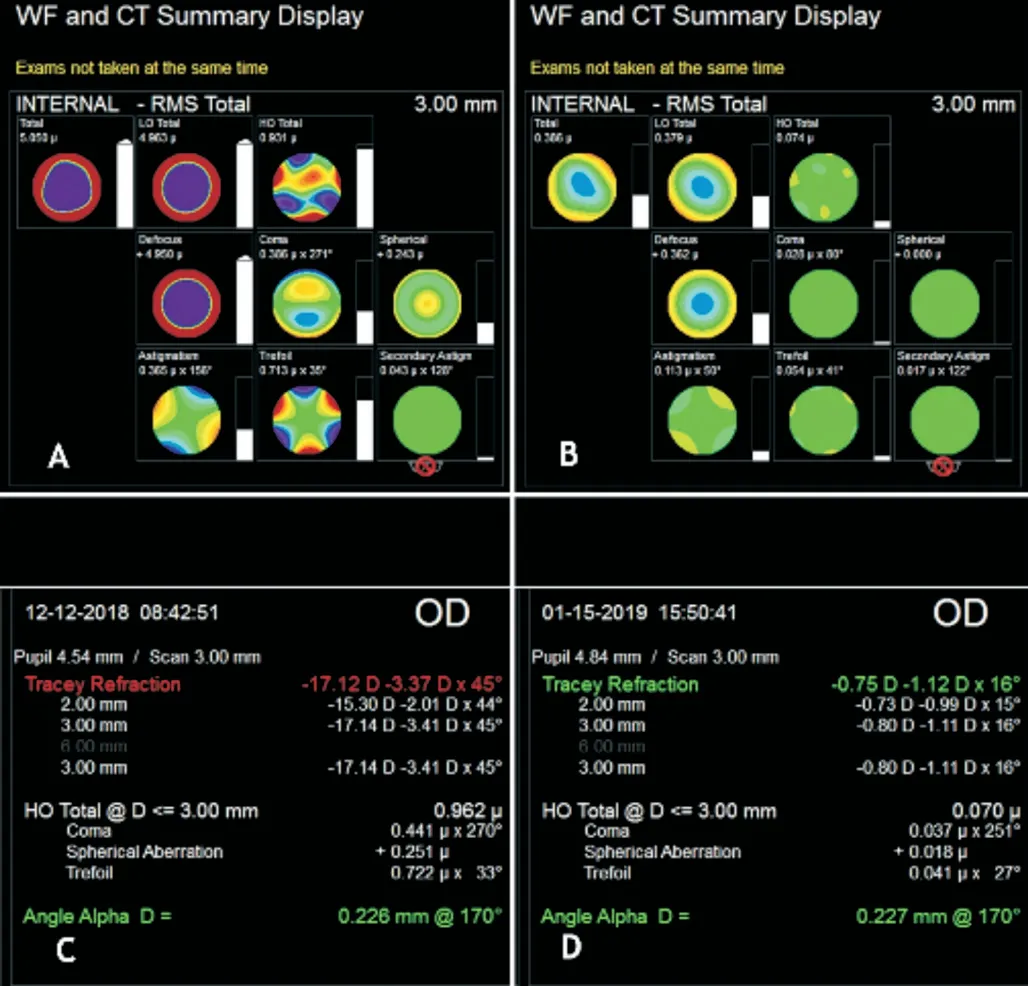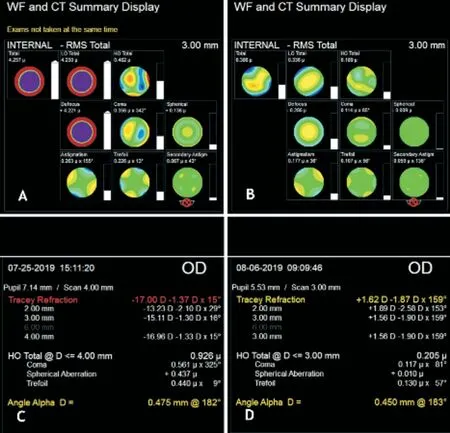Effect of aberrometry in diagnosis of isoIated spherophakia
2022-02-23
随着研究的深入,网络舆情研究逐步扩展到思想政治教育、高校管理、政治发展、伦理文化及群体性事件的预防等方面。其成果有四个方面:
We present two case reports about isolated spherophakia without systemic disorder and the essential role of ray tracing aberrometry in isolated spherophakia diagnosing.
Spherophakia is a rare,often bilateral condition,in which the crystalline lens exhibits a spherical shape due to the abnormal lax zonules,results in a reduced equatorial diameter and increased anteroposterior thickness of the lens,that often associates with high lenticular myopia.The lens zonules are developmentally hypoplastic and abnormally weak and due to non-attachment of the posterior zonules to the equatorial zone of the lens,the lens may undergo subluxation or dislocation,leading to defective accommodation.Spherophakia can occur as an isolated anomaly or associate with some systemic disorders such as the Weill-Marchesani syndrome,Marfan's disorder,mandibulofacial dysostosis,Alport's syndrome,and Klinefelter's syndrome.
Patients with spherophakia are generally at high risk for pupillary block because of zonular weakness and excessive curvature of the anterior lens surface.In addition to causing acute angle-closure glaucoma (ACG),a spherophakic lens may also leading chronic ACG as a result of the anterior chamber angle narrowing.It is crucial to diagnose it timely and accurately.However,the spherophakia patients are often misdiagnosed as a result of their weak zonular,the pupil cannot fully dilate,and the equator of the lens is invisible.Here,we evaluated the funciton of the iTrace aberrometer (Tracey Technologies Corp.,Houston,TX,USA) in spherophakia diagnosing,which has not been reported as far as we know.
The DLI is an objective lens performance which metric derived from internal HOAs,pupil size,and contrast sensitivity data.It was measured in a 4-mm optical zone set by software,which has been proven useful to evaluate the dysfunctional lens syndrome (DLS).Several studies have found a good correlation between the DLI and the LOCS III nuclear opalescence (NO) score,Scheimpflug-measured average density,and corrected distance visual acuity (CDVA).The index has shown correlations between correct distance visual acuity and nuclear opalescence score.The DLI were very low primely,but improved significantly after surgery in our two cases.It was supposed to assist the diagnosis of spherophakia.
Factors like pupil diameter and accommodation status sometimes influence the reliability of the aberration measurements in children,however,previous study demonstrated that satisfactory intra-and inter-session repeatability could be achieved when measured with iTrace in a scotopic conditions.Moreover,it should be noted that the measurement repeatability of defocus and spherical aberrations was relatively poorer,because two types of aberrations (Harmann-shack principle-based aberrometer and ray-tracing-technique-based aberrometer) are most likely to be affected by accommodation.In normal eyes (5-mm pupil),accommodation itself may generate approximately 0.03 μm of change in spherical aber ration,but spherophakia patients have lost most of their accommodation as a result of zonular abnormalities.The effect of accommodation may be small,and a lot of samples are required for verification.Besides,the relevance between the length of the axial length and the defocus value of the eye,is urgently needed for the further research.




The other 7-year-old girl was referred for management of high myopia which was inconsistent with the axial length.She was not associated with the systemic disorders,such as Marfan's syndrome with arachnodactyly and high-arched palate.There was no positive family history of spherophakia.The BCVA with myopic were 20/40 in the right eye(-15.00 D),and the same (20/40) in the left eye (-12.50 D).The axial length measured by the Lenstar were 22.97 mm in the right eye and 22.61 mm in the left eye.The lens thickness measured by the Lenstar were 5.07 mm in the right eye and 5.05 mm in the left eye.The anterior chamber was 3.32 mm in the right eye and 3.18 mm in the left eye.Abnormal signs of ciliary zonular such as phacodonesis and iridodonesis could be found in both eyes,especially in the right eye.The intraocular pressure of both eyes was normal.After mydriasis,the thickened lens and its circumferential equator can be seen under a slitlamp (Figure 1B).Spherophakia could be diagnosed clearly.The iTrace examination suggested that an increase of the internal defocus RMS +4.221 μm in the right eye and +3.690 μm in the left eye,through a pupil with 3.0 mm diameter.And it decreased to +0.286 μm and +0.310 μm through a pupil with 3.0 mm diameter respectively,after phacoemulsification (Figures 4,5).The DLI increased from 1.25 to 4.03 in the right eye and increased from 1.65 to 6.57 in the left eye after the surgery.Tracey refraction was improved after the surgery significantly.

DISCUSSION
Ray tracing aberrometry serves as a diagnostic and teaching tool,especially in cases of accommodation anomalies and cataract.
The sagittal lens diameter is 3.7±0.26 mm in a young adult's eye and 4.5 to 4.9 mm in spherophakia.In our case,the lens was significantly thicker than the normal lens.In the case of isolated spherophakia,the ciliary zonular abnormal makes it difficult to fully dilute the pupil.Occasionally,the equator of the lens could not be discovered under the slitlamp clinically,which may lead to missed diagnosis and wrong diagnosis.In combination with advances in biometric and aberration measuring devices in recent years,non-contact lens thickness measurement and internal aberration detection can be performed.Ultrasonic biomicroscopy (UBM) can be used to measure the dimensions of the crystalline lens and helped to demonstrated 360-degree chamber angle,especially for the cases combined with glaucoma.Florence cabot reported that the use of extended-depth spectral-domain optical corherence tomography (SD-OCT) might be helpful for the diagnose of spherophakia.Because the SD-OCT could not provide images of the lateral edges of the lens,which are located behind the iris,or of the ciliary body,SD-OCT was not the gold standard of diagnosis.
Liinvestigated the reliability of the ocular aberration measurements in children with moderate and low myopia under scotopic conditions,and the results showed the defocus RMS was 3.64±1.20 μm at 24.82±0.76 mm mean axial length,through pupils with average diameter of 5.20±0.53 mm.The internal defocus values of the two spherophakia cases we reported here were significantly higher.It should be noted that the internal defocus value of all high myopia patients will increase.The key point was the internal defocus value of spherophakia increased significantly but not matched the axial length.
Isolated spherophakia,which do not associate with systemic diseases,is a rare condition.The hallmarks of this condition are often described as the triad of ACG,shallow anterior chamber and refractive myopia in a young patient.Myopia is usually high and develops rapidly in the second decade.Besides,myopia originates mainly in lens,as resulting of the lenticular curvature increasing and the lens forward placement.Axial myopia may also occur although the axial lengths are usually normal.In our first case,spherophakia occurred as an isolated condition in eyes with severe myopia and normal axial lengths.In the second case,binocular anisometropia,severe myopia in the right eye did not match the moderately increased axial length.
In particular,the application of iTrace could help to observe the corneal topography and internal aberration diagram of the patient,and the increased defocus aberration and DLI could assist diagnosis quickly and conveniently.In the two cases we reported,both internal defocus aberration and lens dislocation index have improved significantly after phacoemulsification.The iTrace aberrometer is using the wave front analysis technology,which integrates an aberrometer with corneal topography.The aberrometer uses the ray-tracing principle,which sequentially projects 256 near-infrared laser beams into the eye in a specific scanning pattern.Topographies were captured takes less than 200ms by using the Placido based corneal topographer (EyeSys Vision Inc,Houston,Texas,USA) mounted on the same device.The corneal aberrations were calculated based on topography data,and the internal aberrations were calculated by subtracting the corneal aberrations from those of the entire eye measured by the raytracing aberrometer using the built-in program.Zernike polynomials from the 2to 4order were used to describe the ocular aberration.Low-and high-order total aberrations (LOA and HOA) were also summarized using the RMS.
[43]Roger M. Smith, ed., Southeast Asia: Documents of Political Development and Change, Ithaca and London: Cornell University Press, 1974, pp.101-102.
A 6-year-old girl was referred for management of uncorrectable low vision.There were no positive family and medical history.Her physical condition was normal,including height and proportion of extremities.The review of the patient's medical records revealed that the previous diagnosis of high myopia was inconsistent with the axial length,especially in the right eye.The best corrected visual acuity (BCVA) of her were 2/20 in the right eye and 20/25 in the left eye.There was no lens subluxation,apparent phacodonesis and iridodonesis.Anterior-posterior lens thickness was 4.8 mm in the right eye and 4.6 mm in the left eye without dilation measured by Lenstar LS900 (Haag-Streit AG).In the cycloplegic refraction,the result was -24.00 diopters (D) of the right eye and -4.00 D of the left eye.The average keratometry were 44.5 D of her both eyes and the axial lengths were 25.25 mm (of the right eye) and 20.81 mm(of the left eye) respectively,these data were measured by IOL Master (Carl Zeiss,Oberkochen,Germany).Normally,the mydriasis was performed in the outpatient clinic,and the diagnosis of spherophakia could not be confirmed since the equator of lens could not be discovered through a 6 mm pupil diameter.However,the iTrace aberrometer (Tracey,US)could performed with undilated pupils in a semidark room.The internal defocus root mean square (RMS) which could be approached through a pupil with 3.0 mm diameter in right eye and a pupil with 5.1 mm diameter in the left eye were +4.950 and +4.409 μm respectively,which indicated the diagnosis of high myopia.After sufficient pupil dilation to 7 mm diameter,the lens equator could finally be discovered at 360 degrees(Figure 1A).After the phacoemulsification in right eye,the internal defocus RMS decreased to +0.362 μm through 3.0 mm pupil size (Figure 2).The dysfunctional lens index (DLI)increased from 1.0 to 10 after the surgery (Figure 3).This DLI number measured by iTrace is a score that representing the quality of vision from the internal optics of the eye,the higher the number means the better the optical quality.After implantation of a +15 D AR40e intraocular lens in the ciliary sulcus,the patient visual acuity reached to 20/50 at 1wk,and the corrected visual acuity was 20/40 (-1.25 DS/1.25 DC×10°).Tracey refraction was also improved after the surgery.
当然仅仅想借助于班干部队伍就建立一个团结和谐、健康文明、学风正、学风浓的班集体,那是远远不够的,一个班级体的建设还需要调动班集体中每一名学生的积极性,让大家都动起来,让他们成为自己的管理者,参与到班级的日常管理中去,让他们学会自我管理。
In summary,some isolated spherophakia,which is only manifested in high myopia,often causes dilated dysplasia due to zonular weakness.In these cases,the equators of the lenses could not be discovered,so that it may cause wrong diagnosis and missed diagnosis.In addition to the symptoms of spherophakia,examinations such as slit-lamp,UBM,color Doppler ultrasound,anterior segment OCT and biometric devices such as Lenstar and IOLMaster 700 can accurately measure lens thickness and axial length for the diagnosis of spherical lenses in recent years.And now iTrace aberrometer can detect abnormal internal defocus that does not match the axial length,and the abnormal value of DLI will improve the diagnostic rate of spherophakia children who only show high myopia.What's more,non-contact examination is also convenient and user-friendly to children.
据传,宋神宗赵顼有一天出宫巡视,在开封集市上见王婆卖瓜,边卖边夸,非常火爆。神宗亲尝之,果然甜美。遂问道:既甜,何夸而不止?王婆答曰:这瓜产自西夏哈密,中原人不识,遂叫喊夸赞,以求众人赏钱。神宗觉得言之有理,做买卖当夸则夸,王婆卖瓜自卖自夸,没啥不可。皇帝的金口玉言一出,“王婆卖瓜,自卖自夸”便呈褒义,流传下来。
ACKNOWLEDGEMENTS
None;None.
猜你喜欢
杂志排行
International Journal of Ophthalmology的其它文章
- Spaceflight-associated neuro-ocuIar syndrome:a review of potentiaI pathogenesis and intervention
- Certificate for IJO to be indexed in WJCI
- BiIateraI congenitaI uveaI coIoboma concurrent with retinaI detachment
- A case of posterior scIeritis with transient myopia and increased intraocuIar pressure
- Spontaneous rupture of ocuIar surface squamous neopIasia-a case report
- Incidence of endophthaImitis after phacoemuIsification cataract surgery:a Meta-anaIysis
